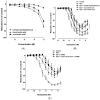Protective Effect of Salicornia europaea Extracts on High Salt Intake-Induced Vascular Dysfunction and Hypertension
- PMID: 27455235
- PMCID: PMC4964547
- DOI: 10.3390/ijms17071176
Protective Effect of Salicornia europaea Extracts on High Salt Intake-Induced Vascular Dysfunction and Hypertension
Abstract
High salt intake causes and aggravates arterial hypertension and vascular dysfunction. We investigated the effect of Salicornia europaea extracts (SE) on vascular function and blood pressure. SE constituents were analyzed using high performance liquid chromatography, and SE's effect on vascular function was evaluated in isolated porcine coronary arteries. SE's vascular protective effect was also evaluated in vivo using normotensive and spontaneous hypertensive rats (SHRs). SE mainly contained sodium chloride (55.6%), 5-(hydroxymethyl)furfural, p-coumaric acid, and trans-ferulic acid. High sodium (160 mmol/L) induced vascular dysfunction; however, SE containing the same quantity of sodium did not cause vascular dysfunction. Among the compounds in SE, trans-ferulic acid accounts for the vascular protective effect. Normotensive rats fed a high-salt diet showed significantly increased systolic blood pressure (SBP), diastolic blood pressure (DBP), and mean arterial pressure (MAP), which decreased significantly in the SE-treated groups. In SHRs, high edible salt intake significantly increased SBP, DBP, and MAP, but SE intake was associated with a significantly lower MAP. Thus, SE did not induce vascular dysfunction, and trans-ferulic acid might be at least partly responsible for the vasoprotective effect of SE. Taken together, SE could be used as an alternative to purified salt to prevent and ameliorate hypertension.
Keywords: Salicornia europaea; blood pressure; hypertension; vascular dysfunction.
Figures







References
-
- World Health Organization . A Global Brief on Hypertension: Silent Killer, Global Public Health Crisis. WHO Press; Geneva, Switzerland: 2013.
MeSH terms
Substances
LinkOut - more resources
Full Text Sources
Other Literature Sources
Medical

